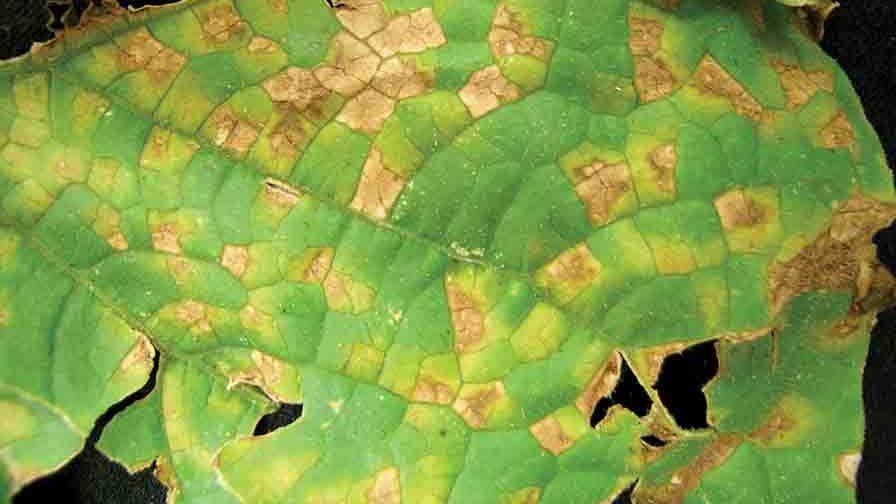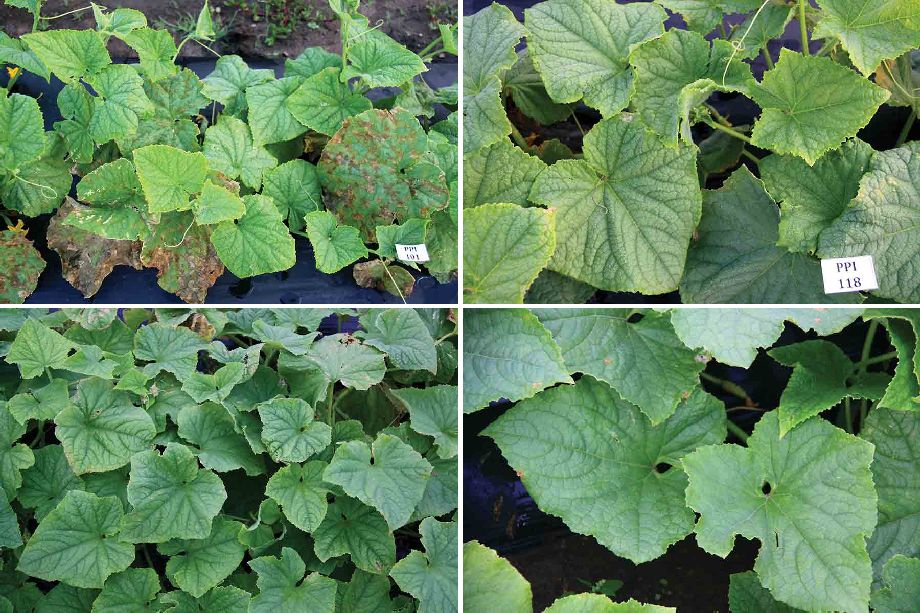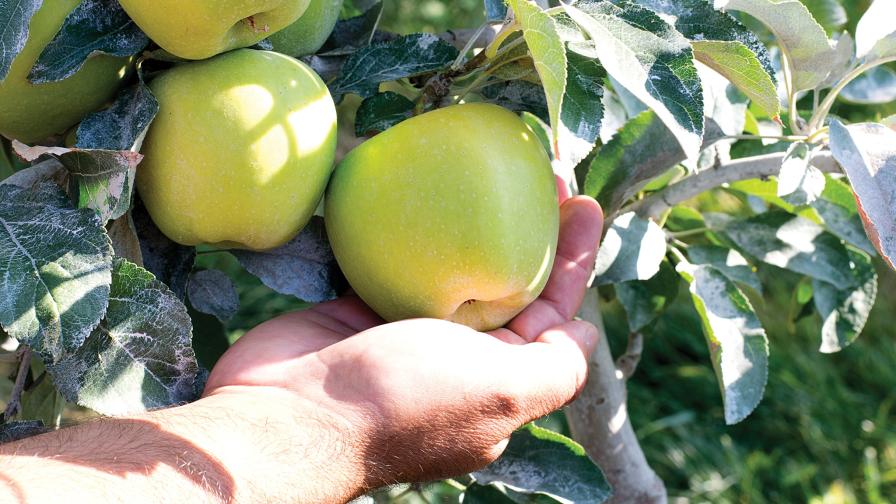Field Scouting Guide: Cucurbit Downy Mildew
Cucurbit downy mildew (Pseudoperonospora cubensis) — or DM — poses a threat to Michigan’s cucurbit crops. Since Michigan in No. 1 in the U.S. for pickling cucumbers, it’s an economic threat that needs to be managed before it gets out of hand.
Cucurbit Downy Mildew
Scientific name: Pseudoperonospora cubensis
Crops affected: cucumber, watermelon, cantaloupe, honeydew, zucchini, gourd, summer and winter squash, and pumpkin.
An Economic Threat
DM is well-known for causing catastrophic losses in a brief period of time.
It spreads to surrounding fields on air currents via tiny, microscopic spores that act as seeds of the pathogen. Cool (~ 60°F), wet, and cloudy conditions create an ideal environment for DM spores to survive outside the host.
When the conditions are favorable, unprotected foliage can become completely blighted within 14 days of the initial infection, resulting in catastrophic yield losses.

Look for yellow lesions on tops of leaves.
Photo courtesy of Michigan State University.
Identifying a Potential Problem
DM causes symptoms on the leaves similar to angular leaf spot. Yellow lesions may be visible on the top surface of infected leaves.
The telltale sign of DM is the gray to black fuzz on the underside of the leaf giving a somewhat “dirty” or “velvet” appearance. This fuzz may be most evident in the morning.
Ps. cubensis is an obligate biotroph, meaning it cannot live long without a host plant. This condition restricts the pathogen to warmer climates during the winter months, including southern states and greenhouses.
To help achieve early detection of airborne spores, we’ve placed volumetric spore traps in Michigan counties during the growing season.
Spore traps continuously sample the air and collect spores by imbedding them on a film we remove and take to the laboratory for identification and quantification. We use a compound microscope to identify/count Ps. cubensis spores that are present on the film.
The spore traps help us to detect an influx of spores into those production regions where the spore traps are located. Thus, when spore concentrations are high, we can issue alerts for growers to begin their fungicide spray program.

Several fungicides have tested well for efficacy.
Shown here (clockwise, from upper left corner): Untreated sample; Treated with Oronids; Treated with Zing!; Treated with Ranman.
Photos courtesy of Michigan State University.
Mind Your Management Methods
You must manage DM through a fungicide spray program. Before the devastating DM outbreak of 2005, host resistance effectively controlled the disease. Since 2005, the formerly resistant cultivars slow the disease’s progression. However, no current cucumber cultivar has been identified that exhibits complete DM resistance.
A fungicide management strategy should include applying the most effective products. The Hausbeck Lab continues to evaluate new and existing products annually to determine the most effective fungicide products available for DM control. Check for similar reports in your own state.
Research has found that the DM pathogen may be resistant to fungicides that were once extremely effective. Rotating among FRAC groups (different modes of action) is imperative to delay development of resistance in the DM pathogen to new chemistries.
Fungicide Recommendations
The table below lists the products that have tested effective against DM in replicated field trials. Each product should be mixed with a protectant (chlorothalonil or mancozeb) or other DM fungicide.
|
Product |
Active ingredient | FRAC |
Tips |
| Orondis Opti SC (Syngenta)* | oxathiapiprolin/ chlorothalonil | 45/M05 | Make no more than two sequential applications before rotating to a fungicide with a different mode of action (FRAC). Use either soil applications of Orondis or foliar applications of Orondis Opti A, but not both for disease control. Do not use for more than 1/3 of the total foliar fungicide applications.
|
| Elumin SC (Valent USA)* | ethaboxam | 22 | Alternate with a non-FRAC Group 22 fungicide. Mix with chlorothalonil or mancozeb.
|
| Ranman 4SC (Summit Agro)* | cyazofamid | 21 | Alternate with a non-FRAC Group 21 fungicide. Mix with chlorothalonil or mancozeb.
|
| Zampro 4.4SC (BASF) | ametoctradin/ dimethomorph | 45/40 | Labeled for application via drip or as a foliar spray. Make no more than two sequential applications before rotating to a fungicide with a different mode of action (FRAC). The addition of a spreading/penetrating adjuvant is recommended. Mix with chlorothalonil or mancozeb.
|
| Gavel 75DF (Gowan) | zoxamide/mancozeb | 22/M03 | Mix with chlorothalonil or other DM fungicide.
|
| Zing! SC (Gowan) | zoxamide | 22/M05 | Make no more than two sequential applications before rotating to a fungicide with a different mode of action (FRAC). Mix with chlorothalonil or other DM fungicide.
|
*These products have performed exceptionally well in Michigan trials.
Editor’s note: Drs. Hausbeck and Linderman updated this article, which was originally published on Michigan State University’s site.









